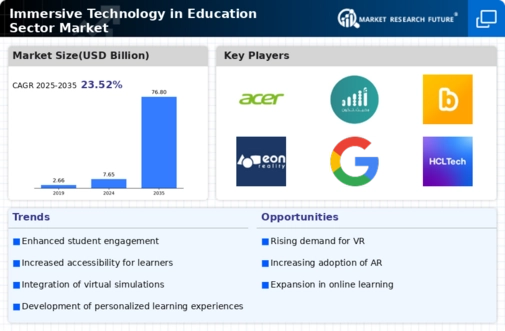Market Share
Immersive Technology in Education Sector Market Share Analysis
The Immersive Technology in Education industry is transforming education and giving students immersive and engaging learning experiences. VR and AR in education are becoming increasingly popular. Users can explore VR-simulated worlds, while AR adds digital material to the actual world to improve learning. In science, history, and vocational training, immersive experiences allow students to interact with complicated topics and events, improving learning and recall.
Another trend is schooling incorporating Mixed Reality (MR). VR and AR are combined in MR to create interactive worlds where digital and actual items interact. This trend is driving the creation of educational apps that combine real-world and virtual features for a smooth and dynamic learning experience. MR is enabling immersive learning through virtual field visits and collaborative problem-solving.
In addition, immersive technology is being used for skill-based training and simulations. In healthcare, aviation, and manufacturing, virtual simulations let trainees practice and improve abilities without danger. This approach improves hands-on learning, giving students practical experience before entering real-world circumstances. Medical students can practise surgery in a virtual operating room in a regulated and realistic environment.
Immersive language learning technology is also growing. Students learn language and culture by experiencing real-life language scenarios in virtual worlds. Virtual discussions, realistic cultural experiences, and authentic language practise are available to language learners. This trend is improving language learning by making language instruction more dynamic and participatory.
Immersive content production tools for schools are also trending. As demand for immersive learning experiences rises, educators want easy-to-use tools to develop and personalize immersive material. This trend allows teachers to create curriculum-specific virtual classes, simulations, and interactive content, encouraging creativity and innovation.
Immersive technology in education is also seeking to make immersive experiences more accessible. Accessibility issues are being addressed to make immersive learning accessible to all students, especially those with unique learning requirements. To provide immersive experiences for a variety of learners, this approach entails building adaptable technology, offering different forms of engagement, and incorporating universal design principles.
The market is also integrating AI with immersive technologies to customize learning. AI algorithms monitor student interactions and performance in immersive environments to customize information and activities for learning styles and development. This approach promotes flexible learning paths that let students study at their own speed and get tailored interventions.













Leave a Comment